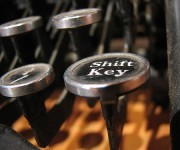Shifting to clean energy will be harder if we don’t let go of old systems now. (Photo by Marya.)
This post originally appeared on Energy Self-Reliant States, a resource of the Institute for Local Self-Reliance’s New Rules Project.
As Americans transition their electricity system to the 21st century, they should ask this question: Does it make sense to pursue strategies such as accelerating the development of new high-voltage power lines that reinforce an outdated paradigm of electricity delivery, or should scarce energy dollars be spent to add new clean, local energy to the grid in the most cost-effective manner?
Fossil-fuel power lends itself to centralized power systems, requiring long supply lines (rail or pipeline) to provide a constant supply of fuel and significant economies of scale in thermal energy production. These supply lines and huge power plants require enormous concentrations of capital, concentrating not only power generation but control of the grid. This explains the 20th-century electricity system.
Renewable energy is fundamentally different. Wind, solar, and geothermal are available everywhere and are so broadly commercially viable that 31 states could meet their entire electricity need with in-state renewable energy resources. It’s also modular, with large-scale wind and solar power plants made up of smaller increments of two megawatts (wind) or 250 Watts (solar). There are much more modest economies of scale for both wind and solar, no long supply lines, and much smaller capital requirements for cost-effective power generation. Thus, renewable energy lends itself to a decentralized system of power generation and ownership.
Mixing the 20th-century centralized paradigm with the 21st century renewable-energy paradigm can be an exercise in futility.
The challenge is technical and political.
Technically, large quantities of renewable energy are incompatible with big coal and nuclear power plants that can’t adjust their output to accommodate more wind and solar. For example, traditional large-scale thermal power plants operate effectively only at high capacity. They can’t scale their production rapidly to adjust to fluctuations in demand, so utilities tend to be careful to build only enough “baseload” capacity to fulfill the minimum level of demand. More adjustable natural gas and diesel generators provide the rapid-response power necessary to meet hour-to-hour and minute-to-minute changes in grid needs. Simply put, a clean-energy grid needs more flexible power plants and fewer baseload ones.
The Germans, with their sights set on a 100 percent renewable energy grid, have already confronted this problem. In a report by their renewable energy agency, they note that:
Clearly, on many days in the year, no traditional base load power plants — those that run year-round — will be needed at all. This will be the case if the feed-in from renewables is particularly high and consumption particularly low. The traditional base load power plants will have to be shut down completely at these times. If the residual load then increases again, i.e. if electricity generation from renewable energies drops, and/or the demand for electricity rises, power plants which can provide regular energy fast from a standstill will be needed. But that is exactly what base load power plants cannot achieve. Nuclear power plants for example have a technically mandated minimum down time of approx. 15 to 24 hours, and it takes up to two days to get them up and running again.
Simply put, a clean-energy grid is technically incompatible with a grid management strategy that prioritizes always-on, baseload power from fossil fuel and nuclear plants. It’s like mixing typewriters and iPads. The following graphic provides a nice illustration of the necessary paradigm shift.
In a way, this vision is not a radical departure. Inflexible generation is still the priority, but in the new paradigm your “always-on” power sources are variable. On top of that, flexible energy sources are stacked (including energy storage and demand-side management). For greater detail on the technical and economic components of this shift, see our report on democratizing the electricity system released in mid-2011.
But the transition to a clean-energy future is not just technical, it’s political. With electricity consumption relatively flat, achieving clean-energy goals rapidly will mean curtailing output from existing fossil-fuel power plants. It becomes a battle between the established financial interest of utilities and clean-energy producers. That’s because incumbent utilities own coal and nuclear plants and find it more financially attractive to operate them than to buy power from independent wind and solar producers. Maximizing clean-energy production means a transformation in the technology powering the grid, but also of the entities who control the grid.
This battle is already underway, writes Anne Butterfield of Daily Camera:
Coal doesn’t just present financial uncertainties, it also hampers clean energy. Wind plants selling power to Xcel in Colorado have seen more of their power curtailed for the sake of coal (which cannot ramp up and down for renewable sources the way that natural gas or hydro can). Since Xcel makes its return on its coal plants and not on wind plants owned by others, it will often run their coal when forced to choose.
Xcel’s cost of wind curtailment has jumped 30-fold in the past three to four years, a hike in which customers pay twice — once for the wind contract and again for the coal when it displaces the wind.
The prioritization of renewable energy, developed in a decentralized fashion, will undermine the traditional utility financial model. Thousands of megawatts of distributed wind and solar can be added to the existing grid, near cities and towns where electricity is used, and at a minimum of expense. For utilities dependent on building power plants and power lines to make a return on investment, the new decentralized, low-infrastructure electricity system is anathema.
To reuse our analogy of the technical problems, what’s happening is the typewriter industry is using its vast resources to try and kill the iPad, only this time the typewriters have guns.
Utilities have responded by clamping down where they can, limiting access to the grid for independent power producers and attempting to corner the market on clean energy added to their grid system. Allowing them to do so will undermine the progress on clean energy, as utilities will wastefully cram inherently decentralized renewable energy production into an outdated centralized power paradigm. They will overbuild infrastructure to make the best return, and they will also limit the dispersion of economic benefits from clean energy.
There’s a need for urgency, because decisions made now in the utility planning process can be on the balance sheet for 50 years or more. Is it really time to be building new coal plants that we’ll have to pay for until 2061 when solar is likely to be cheaper than any other power source by 2020?
America’s clean energy future requires a paradigm shift in the utility system, and there’s no time to waste. The technical challenges are significant but surmountable, and already the leading countries, like Germany, are finding the solutions. The political challenges must also be confronted, and all it takes is action.
Americans can tell policymakers that they want a future dominated by clean energy, rather than existing utilities. They can advocate for opening data on the utility distribution system to allow more distributed energy development, as the California Public Utilities Commission has required. They can advocate for sensible incentives for renewable energy that broaden the opportunities for ownership, as the cash grant program has done. And they can support CLEAN Contracts, or feed-in tariffs, that require utilities to connect and contract with distributed renewable energy producers.
Renewable energy has opened the door to a democratized electricity system, and Americans need to reach out and grasp it.



